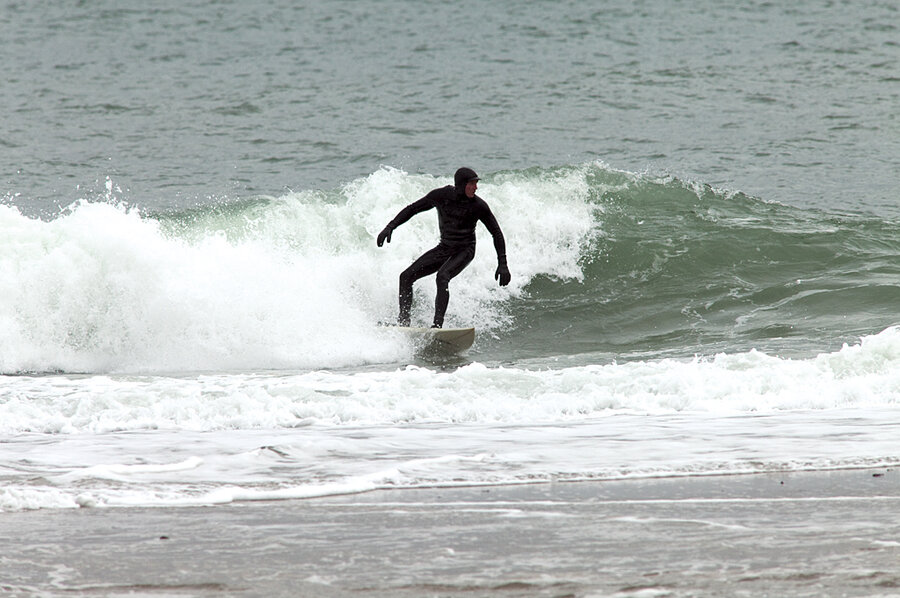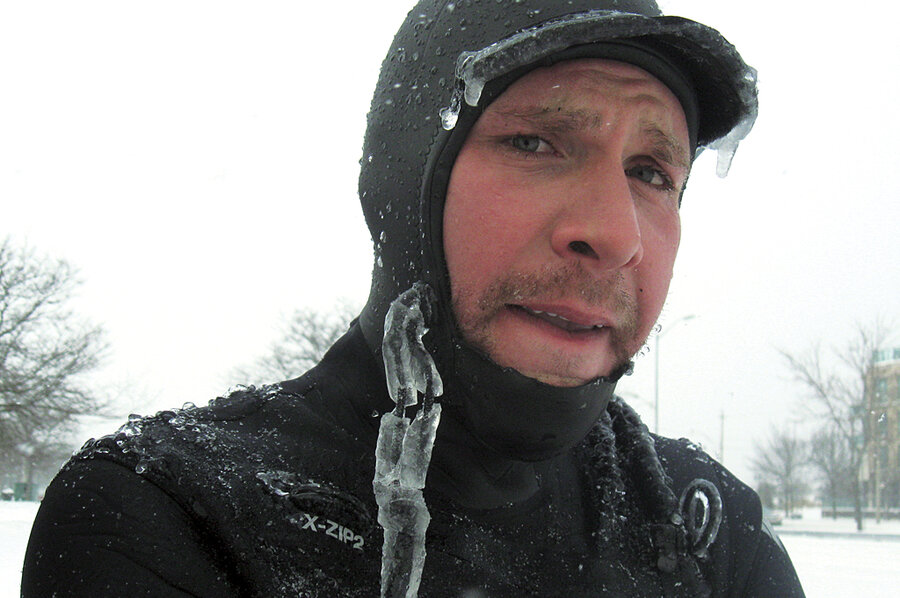Surfing in the winter
| Toronto
Their form-fitting, neoprene black wet suits stand out in sharp relief as Mike Sandusky and Rob Baytor plow through untouched snow about a foot deep in Toronto's Ashbridge's Bay Park, rushing to reach the ice-encrusted beach at the edge of Lake Ontario. They raise their surfboards and jog into the water just as the morning light finally starts to filter through the cloud cover and gently falling snow, the remnants of the brutal winter storm that had hit Toronto the night before. The air temperature is about 25 degrees F. but feels closer to zero degrees because of the wind chill, and the water is just a few degrees above freezing.
"You get the biggest waves right after a winter storm," says Mr. Sandusky, who owns Surf Ontario, an equipment retailer for his chosen sport. "I've been surfing in the winter almost every swell in the last four years and we've been selling a lot more suits and boards this year. It's safe to say it's doubled in the last four years and growing."
The snow continues to fall as Mr. Baytor and Sandusky paddle their boards a couple of hundred yards past the whitecaps, and three more wet-suited surfboarders arrive and take the plunge.
When considering the great surfing hot spots, one doesn't instantly think of the Great Lakes or the Northeastern Atlantic coast of the United States. But winter surfing is growing in popularity due, in large part, to the improvements in wet-suit technology. Small surfing communities can be found as far north as Newfoundland and all the way down the Eastern Seaboard, and the frigid waters and the brutal winters of the Northeast only seem to encourage the die-hards who say the stormier the weather, the better the surfing.
Sandusky and Baytor used to ski and snowboard, but they admit that surfing has taken over both their winter and summer sporting schedule.
"It's more extreme, kinda more intense because [when you're snowboarding] you don't have a five-foot wave coming down on you," says Baytor, who is an artist. He adds that cold water can really hit a surfer hard.
"But it's good for you," Sandusky argues back, "improves circulation, boosts your immune system." Baytor laughs, saying "Easy there, David Suzuki," referring to a well-known Canadian scientist and broadcaster.
Sandusky first discovered surfing while he was spending a winter in Hawaii shortly after university.
"I came back from my trip and thought, 'there's waves on the lake!' I thought I was the first person to think of [surfing here]," he recalls with a laugh. "Then I got out there and discovered that people had been doing it since the '60s. At first I thought surfing in the winter was crazy, and then I bought a wet suit and discovered that it's not so bad."
Wet suits are most often made from neoprene, a buoyant, fairly flexible rubber. The first surfing wet suit was designed and commercially sold by an avid young surfer in San Francisco named Jack O'Neill back in 1952. These early suits allowed surfers to extend their seasons into fall and winter.
Kieran Horn is the marketing manager for O'Neill Wetsuits, now of Santa Cruz, Calif. "The biggest difference with the modern suits is in the materials and the seam construction," he says. "The foam has gotten more stretchy, and when you have a more flexible wet suit you can have a thicker wet suit. That has opened up new boundaries for surfing, like in the Northeast."
Julie Baldwin, who lives near Halifax, Nova Scotia, can attest to the flexibility. A member of the Canadian national surfing team and mother of two, she says, "I surfed until I was 7 months, 3 weeks during my first pregnancy and 8 months, 3 weeks [into] my second. I finally had to give up when my wet suit got too tight and it just wasn't comfortable anymore."
Ms. Baldwin says she did check with a surfing buddy who is an emergency room doctor to make sure it was safe to surf in her condition. He gave her the go-ahead but told her to make sure she knew her limits. "Frostbite and hypothermia do occur definitely," she says. "I think those generally happen in your earlier stages of surfing, when you are under the water more from falling, and not as familiar as to where to be or go to avoid extra submerged time."
"Most surfers would probably agree that they have suffered from minor frostbite on their feet," she adds. "Generally this means it takes longer to warm up after a winter session. When your feet start to get cold, you should get out." She adds that winter surfers tend not to "listen" to their feet, and that finishing a session with almost no feeling in them is common.
Jim Cunning agrees that knowing your limits is key to avoiding the dangers of a frigid surf. He lives in Orleans, Mass., and is an instructor at the Cape Cod Surf Camp.
"The cold can get exhausting, and it can make you make bad decisions or throw your timing off. That's something that can happen with beginners," he says. "It's the numb fingers that bother me the most." That and getting hit in the face with a wave. "It's like having a giant ice-cream headache all over your head. You have to stay focused and remember not to breathe in."
But, Mr. Cunning says, "Everyone who surfs on Cape Cod eventually ends up surfing in the winter.... The waves here are smaller than you would get in Hawaii or California but they're superfast and they have so much energy and power."
According to his surfing buddy, Jeff Cronin, who went to graduate school to study atmospheric sciences so that he could more ably forecast the local surfing conditions, the reason for the fast, powerful waves is that "The nor'easter comes up and the winds blow towards the coast and the ocean is basically a washing machine. As [the wind] goes past us, it blows back offshore and that cleans up the waves and creates that mare's-tail that you see" in the surfing movies. He adds, "Our ideal would be a hurricane going by in September or October."
Mr. Cronin, who lives in North Eastham on Cape Cod, says, "A lot of times, I'm scared, but when I'm done, I feel amazing. Like a runner's high – but 10 times better."
He has been surfing for more than 20 years, and started winter surfing about 10 years ago. "Basically I eased into it around the time of 'The Perfect Storm' in '91 or '92 before the wet suits got good. Sometimes we had to wear two suits," he recalls.
Meanwhile back in Toronto, Sandusky, and Baytor finally emerge from the water. Their faces are bright red from the cold, and icicles are hanging off the peaks of their wet-suit hoods, but they're both wearing exhilarated grins. The cold hits them once they're out of the water and they grab their gear and race back to their vehicle. They crank up the heat to stay warm until they can get home and remove their wet suits under a hot shower.
Sandusky says, "If I couldn't surf, I wouldn't live here, but I still prefer surfing in the summer, even though the waves are bigger now and in the fall."
Baytor concurs: "It's better than not surfing at all."







